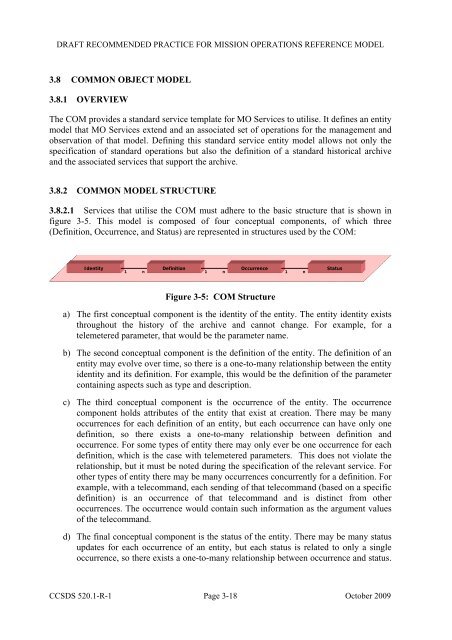Mission Operations Reference Model. Draft ... - CCSDS
Mission Operations Reference Model. Draft ... - CCSDS
Mission Operations Reference Model. Draft ... - CCSDS
You also want an ePaper? Increase the reach of your titles
YUMPU automatically turns print PDFs into web optimized ePapers that Google loves.
DRAFT RECOMMENDED PRACTICE FOR MISSION OPERATIONS REFERENCE MODEL3.8 COMMON OBJECT MODEL3.8.1 OVERVIEWThe COM provides a standard service template for MO Services to utilise. It defines an entitymodel that MO Services extend and an associated set of operations for the management andobservation of that model. Defining this standard service entity model allows not only thespecification of standard operations but also the definition of a standard historical archiveand the associated services that support the archive.3.8.2 COMMON MODEL STRUCTURE3.8.2.1 Services that utilise the COM must adhere to the basic structure that is shown infigure 3-5. This model is composed of four conceptual components, of which three(Definition, Occurrence, and Status) are represented in structures used by the COM:IdentityDefinitionOccurrence1 n 1 n1 nStatusFigure 3-5: COM Structurea) The first conceptual component is the identity of the entity. The entity identity existsthroughout the history of the archive and cannot change. For example, for atelemetered parameter, that would be the parameter name.b) The second conceptual component is the definition of the entity. The definition of anentity may evolve over time, so there is a one-to-many relationship between the entityidentity and its definition. For example, this would be the definition of the parametercontaining aspects such as type and description.c) The third conceptual component is the occurrence of the entity. The occurrencecomponent holds attributes of the entity that exist at creation. There may be manyoccurrences for each definition of an entity, but each occurrence can have only onedefinition, so there exists a one-to-many relationship between definition andoccurrence. For some types of entity there may only ever be one occurrence for eachdefinition, which is the case with telemetered parameters. This does not violate therelationship, but it must be noted during the specification of the relevant service. Forother types of entity there may be many occurrences concurrently for a definition. Forexample, with a telecommand, each sending of that telecommand (based on a specificdefinition) is an occurrence of that telecommand and is distinct from otheroccurrences. The occurrence would contain such information as the argument valuesof the telecommand.d) The final conceptual component is the status of the entity. There may be many statusupdates for each occurrence of an entity, but each status is related to only a singleoccurrence, so there exists a one-to-many relationship between occurrence and status.<strong>CCSDS</strong> 520.1-R-1 Page 3-18 October 2009
















